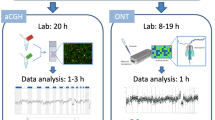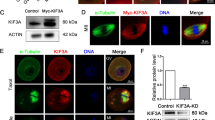Abstract
Spermatogonial and primary spermatocyte chromosomes of Paragomphus lineatus (Selys) and Nepogomphus modestus (Selys) of family Gomphidae have been described on the basis of C-banding and NOR staining. Both the species possess 2n (♂) =23, n (♂) =12 without m chromosomes with XO(♂)/XX(♀) type sex determining mechanism. The sex chromosome is the largest element in the whole complement in Paragomphus lineatus but it is medium sized in Nepogomphus modestus. In Paragomphus lineatus, all the autosomal bivalents possess terminal C-bands while X chromosome is C-positive throughout the length but lightly stained in the centre. Similarly, terminal NOR bands are present on all the autosomal bivalents and X chromosome shows terminal NOR bands with large interstitial band. In Nepogomphus modestus, all the autosomal bivalents except one bivalent possess terminal C-bands while X chromosome represents large C-positive region on one end and small C-negative region on the other end. NOR staining shows terminal / non terminal NOR bands on some autosomal bivalents while X chromosome possesses dark NOR band only on one end.


Similar content being viewed by others
References
Agopian S, Mola LM. Intra and Interspecific karyotype variability in five species of Libellulidae (Anisoptera: Odonata). Caryologia. 1988;41:69–78.
Carr DH, Walker JE. Carbol- fuchsin as a stain for human chromosomes. Stain Technol. 1961;30:233–6.
Frankovic M, Jurecic R. Comparative cytogenetic analysis of karyotype morphology and organization in males of species Libellula depressa and Libellula fulva (Insecta: Odonata). Period Biol. 1989;91:32–3.
Grozeva SM, Marinov MG. Cytogenetic study of Somatochlora borisi (Odonata: Cordullidae), and three relative species. Acta Zool. 2007;59:53–8.
Howell M, Black DA. Controlled silver staining of nucleolar organizer regions with protective colloidal developer: I step method. Experientia. 1980;36:104–5.
Kiauta B. Sex chromosomes and sex determining mechanism in Odonata, with a review of the cytological conditions in the family Gomphidae and references to the karyotypic evolution in the order. Genetica. 1969;40:127–57.
Kiauta B. Synopsis of the main cytotaxonomic data in the order Odonata. Odonatologica. 1972;1:73–102.
Kiauta B. Cytotaxonomy of dragonflies, with special reference to the Nepalese fauna. Nepal Research Centre Kathmandu. 1975; p.1-78.
Mola LM, Papeschi AG. Holokinetic chromosomes at glance. J Basic Appl Genet. 2006;17:17–33.
Nokkala S, Laukkanen A, Nokkala C. Mitotic and meiotic chromosomes in Somatochlora metallica (Cordulidae, Odonata). The absence of localized centromeres and inverted meiosis. Hereditas. 2002;136:7–12.
Perepelov EA, Bugrov AG, Warchalowska-Sliwa E. C-banded karyotypes of some dragonfly species from Russia. Folia Biol. 1998;46:137–42.
Perepelov E, Bugrov AG. C-heterochromatin in chromosomes of Ophiogomphus cecilia cecilia (Anisoptera: Gomphidae) with notes on the sex chromosome origin in the species. Caryologia. 2001;54:169–72.
Perepelov EA, Bugrov AG, Warchalowska-Sliwa E. C-banded karyotypes of some dragonfly species from Russia. II. The families Cordulegasteridae, Corduliidae and Gomphidae. Folia Biol. 2001;49:175–8.
Prasad R, Thomas KI. C-band pattern homogeneity in dragonflies (Odonata). Caryologia. 1992;45:57–68.
Subramanian KA. Dragonflies of India- A field guide. Vigyan Prasar, New Delhi. 2009; pp. 1–168.
Sumner AT. A simple technique for demonstrating centromeric heterochromatin. Exp Cell Res. 1972;75:304–6.
Suzuki K, Saitoh K. Germ-line chromosomes of two species of Davidius, with special reference to the sex chromosomes (Anisoptera: Gomphidae). Odonatologica. 1988;17:275–80.
Thomas KI, Prasad R. A study on the germinal chromosomes and C-band patterns in four Indian dragonflies (Odonata). Perspect Cytol Genet. 1986;5:125–31.
Tyagi BK. A note on the karyotypes of Burmagomphus pyramidalis and Onychogomphus saundersi duaricus (Anisoptera: Gomphidae). Odonatologica. 1977;6(9):277–82.
Tyagi BK. Studies on the chromosomes of Odonata of Dun Valley (Dehradun, India). Ph. D. thesis, University of Garhwal, Srinagar. 1978.
Tyagi BK. The chromosome number and sex determining mechanisms newly recorded in thirteen Indian dragonflies (Odonata). Chrom Inf Serv. 1978;25:5–7.
Tyagi BK. Cytotaxonomy of the Indian dragonflies. Indian Rev Life Sci. 1982;2:149–61.
Walia GK. C-band pattern in four species of dragonflies. Abstr. In: National Congress of Entomology, Patiala. 2006; p. 145.
Walia GK. C- heterochromatin in chromosomes of dragonflies (Odonata). Abstr. In: “Eightth International Symposium of Odonatology”, Nagpur. 2008; p. 75.
Walia GK. C-heterochromatin heteromorphism in Ceriagrion coromandelianum (Odonata: Zygoptera: Coenagrionidae). Abstr. In: “International Conference on Entomology”, Patiala. 2009; p. 119.
Walia GK, Sandhu R, Goyal S. Cytogenetical analysis of Nepogomphus modestus from Palampur area of Himachal Pradesh, India (Gomphidae: Anisoptera). Chromatogr Sci. 2006;9:99–100.
Author information
Authors and Affiliations
Corresponding author
Rights and permissions
About this article
Cite this article
Walia, G.K., Chahal, S.S. Distribution of constitutive heterochromatin and nucleolar organizer regions in two species of family Gomphidae (Odonata: Anisoptera). Nucleus 57, 223–227 (2014). https://doi.org/10.1007/s13237-014-0122-z
Received:
Published:
Issue Date:
DOI: https://doi.org/10.1007/s13237-014-0122-z




